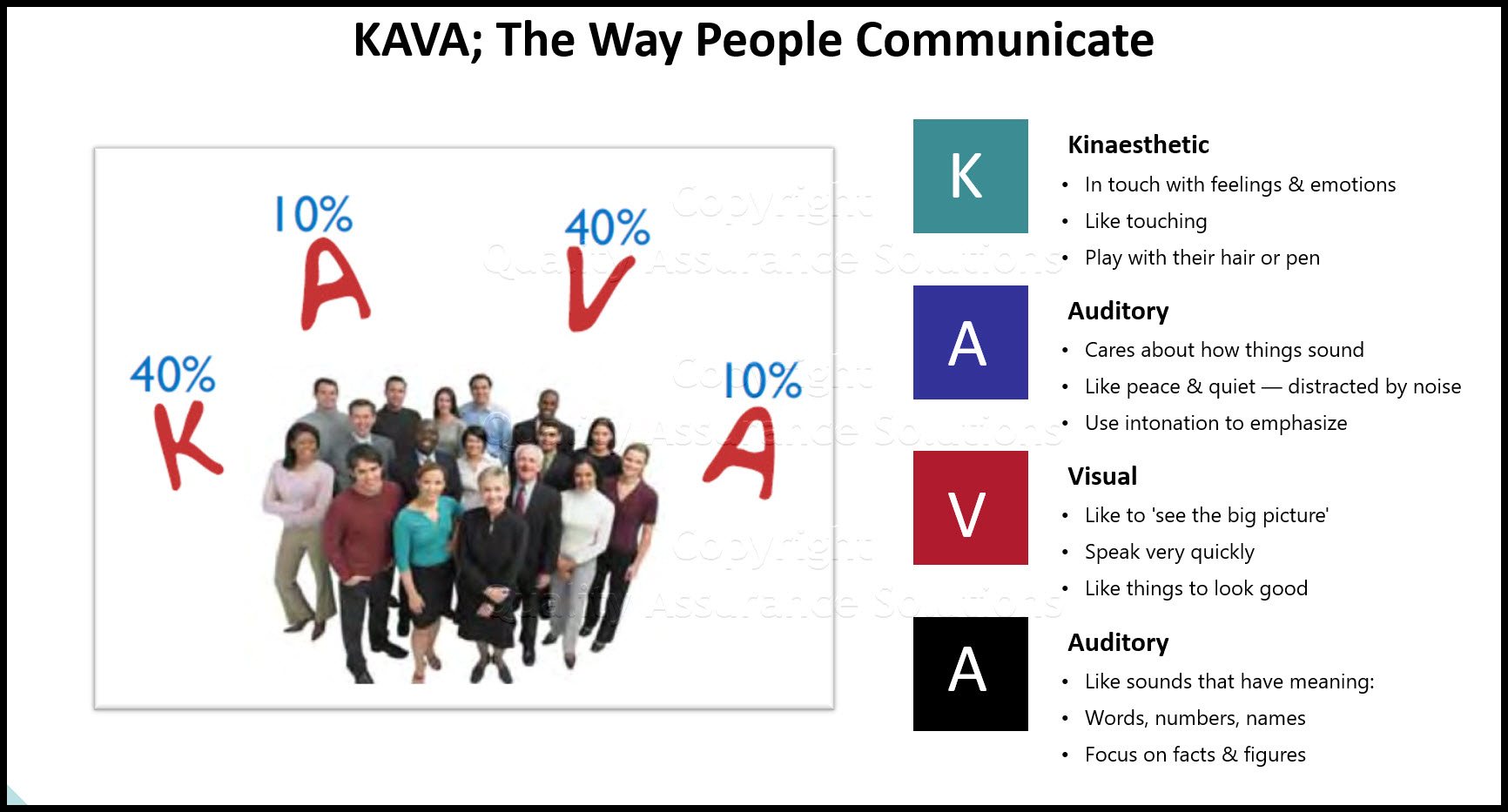KAVA Meaning
Discover the KAVA meaning to improve your communication process. We all have our own way of communicating, the words we choose reveal our
representational system.
In the western world, 40% of the people are kinaesthetic, 10% auditory, 40% visual and the final 10% are auditory-digital.
Kinaesthetic 40%
- In touch with feelings & emotions
- Like touching
- Play with their hair or pen
- Speak softly, gently and slowly
- Say...
'This doesn't feel right.'
'l get your drift.'
'l understand how you feel.'
- Look down
- Breathe from bottom of stomach
TrainingKeeper Software. Keep, organize and plan all your employees' training and activities. Software includes multi-user support with reports, certs, and calendars.
Auditory 10%
- Care about how things sound
- Like peace & quiet — distracted by noise
- Use intonation to emphasize
- Talk to themselves (listen to their inner voice)
- Say. ..
'We're on the same wavelength.'
'That sounds about right.'
'l hear you, loud and clear.'
- Look side—to—side (at their ears)
- Breathe from middle of chest
Visual 40%
- Like to 'see the big picture'
- Speak very quickly
- Like things to look good
- Think in pictures, so think quicker
- Say.
'You're blowing it out of proportion.'
'From my perspective, it looks like this.'
'l get the picture.'
- Look up
- Breathe high up in chest
Auditory - Digital 10%
Subcategory of Auditory
- Like sounds that have meaning:
- words, numbers, names
- Focus on facts & figures
- Like to work things out before deciding
- Say...
'This makes sense.'
'The specifications are correct.'
'That's logical.'
8D Manager Software with 8D, 9D, 5Y and 4M report generator. Your corrective action software for managing, measuring, and reporting issues.
Charismatic Speakers Use the KAVA Meaning
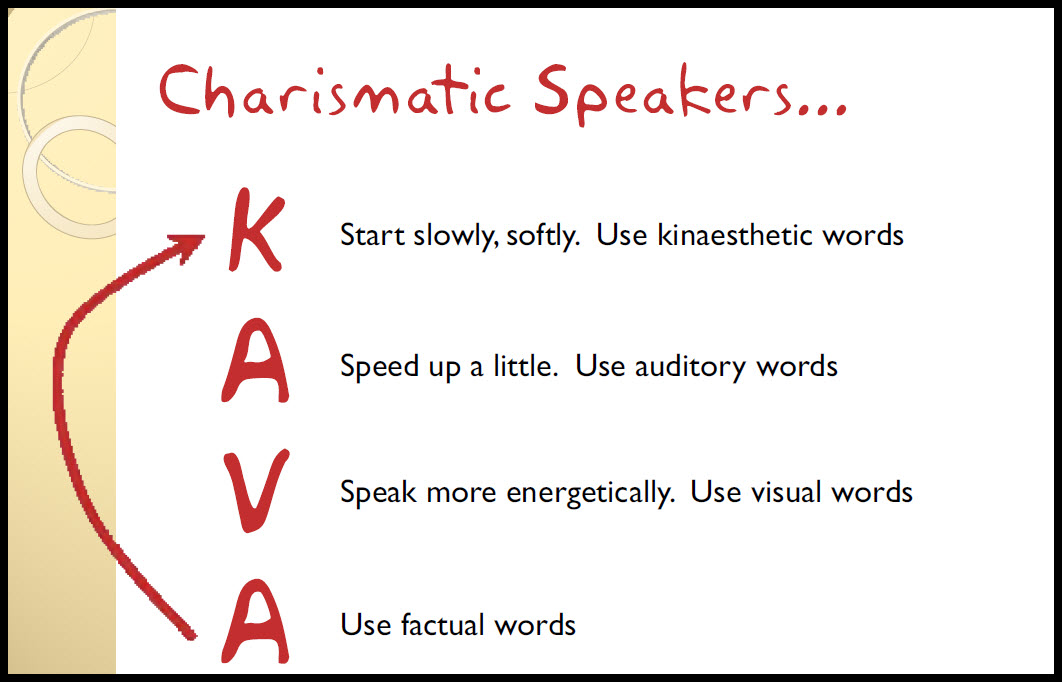
This is the sequence charismatic speakers use — either deliberately or instinctively to create rapport with their audience.
Charismatic speakers engage with the audience by telling stories — in business the stories are usually case studies describing the results and benefits customers received. Keynote speakers often share their experiences, describe how they achieved their goals.
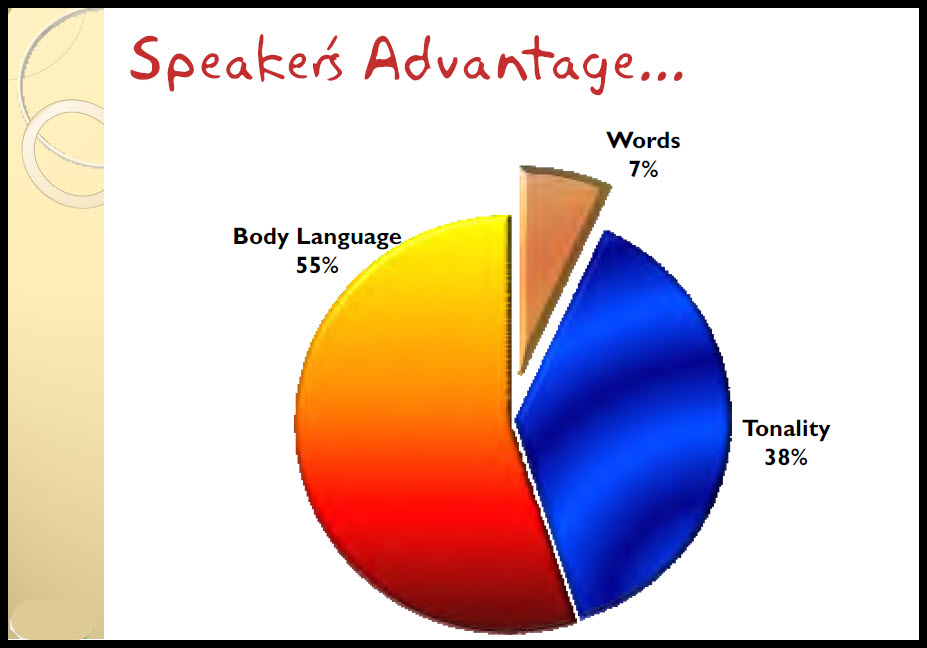
Speakers communicate 100% - they use their body language and tonality in their voice, as well as the words — which is the smallest portion of the communication. They can see their audience's body language and adjust.
Messages
When writing with the KAVA meaning, we only have the words. We can use formatting to emphasize words, but we don't really know how the reader will interpret the emphasis.
Even though we can only use words, our written messages can still follow the charisma formula — use words that connect with the different types of readers and use stories to engage with them.
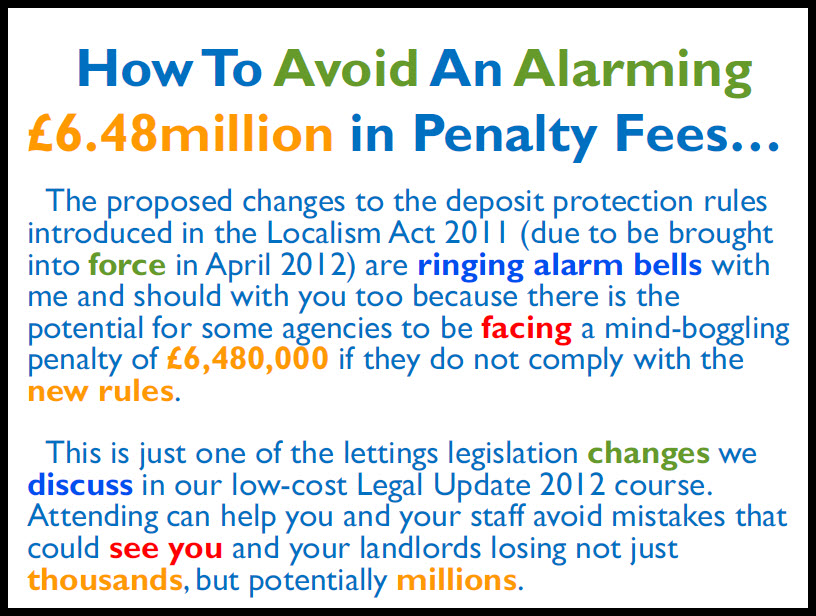
This is an example of a letter that was written for a business that
supplies legal training to property management professionals.
The words are colored to show how the charisma formula is being used.
This letter produced great results. The seats booked, compared to
a previous campaign, and increased by 303.7%.
You can see the KAVA sequence in these two paragraphs from the beginning of the letter.
8D Manager Software with 8D, 9D, 5Y and 4M report generator. Your corrective action software for managing, measuring, and reporting issues.
Sales Letters
Have you noticed how some sales letters seem to 'hit the spot' and others just leave you cold? With some letters, you understand straight away and yet, others don't seem to make any sense.
If you showed the same appealing letter to other people, you'd get some who, like you, appreciate it too. But others may look at it from a different angle and would perhaps, be completely unaffected by it.
Why? because people are different. We all see things from our own point of view and have our own preconceived ideas. We all have our own beliefs and our own experiences, which influence us every day.
Our individual background colors what appeals to us.
This makes it very difficult for you to write in such a way that allows all readers to immediately understand your context.
Use the 'scientific approach' to writing adverts and sales letters. This increases your chances of getting the reaction you want, as described below. You can use this KAVA meaning to increase your success rate.
Start your letter off in a way that captures your reader's interest. Continue in a fascinating and informative way to draw him through every sentence, paragraph and page.
Use a captivating headline or opening sentence; descriptive words and where appropriate, the right pictures, with captions. These all impact on the response you get.
In essence, your sales letter must take these three actions:
- Seize your prospect's attention. If you do not 'stop him or her in their tracks' so they take note of what you are writing about, you won't get a result.
- Sustain interest by focusing on the result of using your product / service.
- Compel your reader. He must be so caught up in your story; he can't resist taking the action you suggest. If your reader does not take favorable action, your letter failed. Use the right language with KAVA meaning.
Employee Handbook Kit includes two Employee Handbook templates for Professional & Manufacturing. Includes over 60 policies and benefits templates.
Using the Right Language
Use the right language to cut through communication barriers. The language you use in your letter or advert is very important. This is because we all have a language base - ways of expressing ourselves that makes sense to us. When other people use the same language as we do, we find we have an affinity with them, and sometimes we seem to 'just click'.
When you offer ideas or suggestions in a conversation you hear some people say "I see what you mean", whereas someone else says "That sounds about right", whilst another responds "That feels good".
In all three sentences each person indicated he/she has understood whatever you proposed, but each phrased his/her thoughts in a way that feels natural to him/her. Each person utilizes the KAVA meaning in their own way.
Visual people often use phrases with a visual connotation like "I get the picture". Using 'picture' words helps them to see your point of view and visualize the outcome.
Auditory people talk about things "sounding 0K". They hear the ideas and can tell if the proposal is a sound proposition. They like sound-based words and phrases.
Kinaesthetic people communicate with their feelings, and make comments like "I get your drift". They relate to the ideas being floated. They naturally appreciate language containing words that create the feelings they want to enjoy, whether it is security, comfort or a stress-free situation.
Capture the essence of these KAVA meaning styles in your writing and you'll' achieve rapport with a greater number of people. Use a mixture of KAVA meaning words so you connect with all the different people who read your letter.
Here are some KAVA meaning words. Use them when writing your letter:
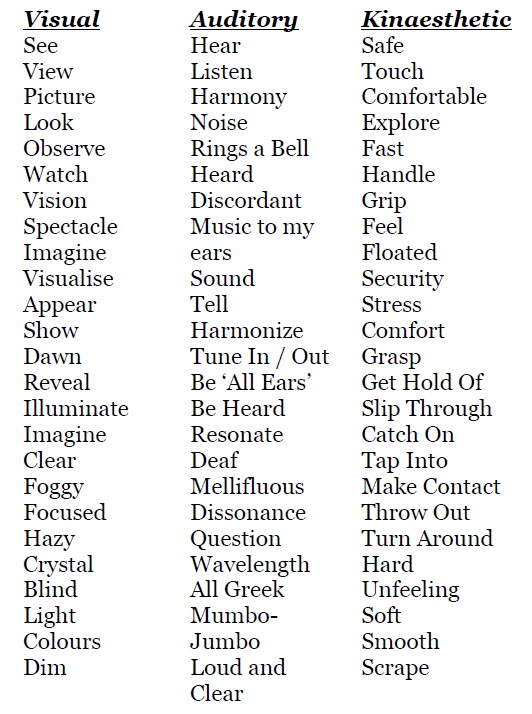
This Data Analysis Video teaches you the basic tools for understanding, summarizing, and making future predictions with your collected data. Includes MS Excel templates.
Do be careful how you employ the different KAVA meaning words - your letter must still flow and make sense to the reader.
Do remember, although we all have our preferred language, we use KAVA meaning words and phrases from the other bases as well.
Paint the picture in your sales presentation; describe how your prospect would use your product or service, what they would see or hear, how they would feel, as in this below example of a car salesman talking to a busy, important company director.
The below description uses all the base senses to create the greatest amount of rapport, regardless of the base preference of the reader.
Let's go through and identify how the KAVA meaning words have been weaved into the 'story'.
I've used the initial letter, before the word, to indicate the 'sense' being used.
[v] - Visual
[a] - Auditory
[k] - Kinaesthetic (Feeling)
I haven't marked all of the words used, just enough to give you an idea of how it works - as you go through you will recognize others:
'Imagine; you [v] look out of your office window on a [k] cold, wintry day. Snow is falling and is already settling in a [a] crisp, [v] white blanket on the ground. The [k] temperature is still dropping.
You have to [k] drive over to see a prospective client. A big contract depends upon you getting there on time.
You smile as you [a] say to yourself "I'm glad I bought the XYZ four-wheel drive last week.
You [k] walk out to the car park; all sound is [a] muffled by the snow [k] lying on the roads, trees and bushes surrounding your offices. You open the car door and slide into the [k] luxurious, soft [v] cream leather seat. The door closes, [a] whisper quiet, matching the peaceful [k] ambience created by the snow.
You switch on the ignition. The engine gives a quick [a] roar as you blip the accelerator. A touch of a button and you feel the warmth permeating through the seat. The powerful, smooth wipers glide across and quickly [v] clear the front and rear screens.
As you slowly pull away you can [k] sense the sure grip and traction of the tires [a] crunching across the snow. The halogen lamps [v] cut a swathe of [v] light through the curtain of falling snow.
The [a] purr of the engine gives the promise of the [k] power and control at your finger tips.
Suddenly, a cat [v] runs across in front of you and you [k] stamp on the brake. The car stops immediately, smoothly, no sliding or skidding. The ABS braking system working exactly as you expected based on what you were told when you were thinking about buying.
You relax, content in the knowledge that you will have a swift and safe journey to the appointment with your prospective client. This car is not going to let you down.
Notice we write this in the present tense which places the reader (or listener) in the scene and experiences the described results.
Get Green Belt Certified with this extensive on-line course. Learn the Six Sigma tools and steps. Earn 25 PMI PDU. Start implementing Six Sigma today
Tell Your Reader They Want to Know
In addition to this, you must make sure you concentrate on your reader. Whilst writing, ask yourself "What does my reader really want to know about?"
Does he/she honestly care about how long your company has been in business? Or what you are trying to achieve.
Statements like: "We had a good result at the last exhibition, and we would like to make this one even more successful. Which is why..."
does not interest him. He doesn't care! Always write from his point of view.
One thing, we all have in common as human beings, we get very interested in our results. How can whatever we purchase help us? "What's in it for me?" Answer this question for your reader as you write. When you write your sales letter - does it clearly explain the results they get?
Remember, use present tense language when you describe the results they get, which keeps them in the moment and experiences what you portray in their imagination. People buy on their emotions. The logic comes later.
- QAS Home
- Communication
- Kava Meaning
|
Quality Assurance Solutions Robert Broughton (805) 419-3344 USA |
 |
|
Software, Videos, Manuals, On-Line Certifications | ||
|
450+ Editable Slides with support links | ||
|
Corrective Action Software | ||
|
Plan and Track Training | ||
|
AQL Inspection Software |
|
Learn and Train TRIZ | ||
|
Editable Template | ||
|
Templates, Guides, QA Manual, Audit Checklists | ||
|
EMS Manual, Procedures, Forms, Examples, Audits, Videos | ||
|
On-Line Accredited Certifications Six Sigma, Risk Management, SCRUM | ||
|
Software, Videos, Manuals, On-Line Certifications |
